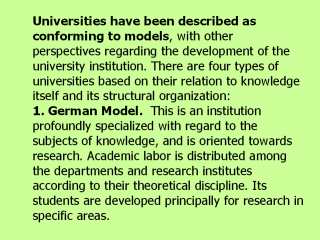 |
2. English Model. It is comprised of two
systems, one at Oxford University oriented towards pure research and the
development of concepts, and the other one dedicated to general education
and developing applications of knowledge to agricultural, industrial and
commercial activities at Cambridge University.
3. French (or Napoleonís) Model. It is based on the idea that a
narrow bridged relation is required between the State and the University
Institution: the university must generate the professionals required by the
State for national development, and not educate students dedicated to
contemplation and scientific speculation. It is comprised of faculties where
the labor is around professional careers which already have a specific field
of employment.
4. The U.S. Model. This was originally divided into two systems:
Schools, Colleges and Universities dedicated to post basic general teachings
with formative character, and on the other hand Liberal Arts Colleges,
Colleges of Arts and Sciences and Schools dedicated to acquire skills for
agricultural labor and mechanical arts. In the second half of the XIXth
century, it introduced the distinction between pre and post graduate
education; it promoted research at institutes and departments such as in the
German Model. |
